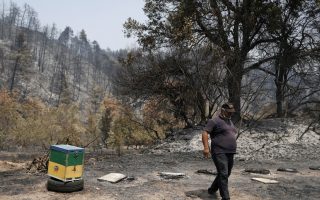Wildfires released ‘extremely harmful’ particles
The British expert who researches the impact of fires on atmospheric composition, talks about the effect of the Greek blazes on air quality

Last week, countless Greeks experienced moments of anguish just inches away from the multiple fire fronts that broke out across the country. The impact of the fires, however, can be detected in the atmosphere several kilometers away.
Mark Parrington, a senior researcher at the European Copernicus Atmosphere Monitoring Service (CAMS), has been studying consecutive satellite images from Greece for days, capturing the extent and impact of the fires. Speaking to Kathimerini about his findings, the tone in his voice is noticeably anxious.
“Beyond the immediate disasters, the effects on the atmosphere and carbon emissions are enormous,” said the British researcher who specializes in the impact of fires on atmospheric composition, urging residents of fire-impacted areas to limit their exposure to outdoor spaces due to the high concentration of harmful particles.
Can we map out the impact of the recent fires on the Greek atmosphere?
It is clear from the measurements and satellite images that, in recent days in Greece, the carbon emissions have increased dramatically. The increase is noticeable both in comparison with previous data for this summer, as well in relation to previous periods of high risk for fires. Copernicus has a database of almost 20 years, with our measurements starting in 2003, something that allows us to compare total carbon emissions from the beginning of June to the end of August. We thus calculate the average of a typical “fire season” for each country. In Greece there is one year in particular that stands out: the heatwave of 2007, when we observed a unique peak in total carbon emissions. If, however, we were to remove that year from the measurements, this year would likely represent the new peak.
What are the effects of fires on the atmosphere and what is the current situation in Greece?
There is a clear and direct effect of fires on the atmosphere, due to the smoke and the airborne particles it contains, many of which are toxic and extremely harmful to human health. In northern Attica and Evia, the satellites show us a clear cloud of smoke that hovered over the area for days, releasing additional pollutants into the already congested urban atmosphere of Athens. A colleague from Greece told me that authorities were advising people to stay indoors due to poor air quality – which is fully in line with our measurements. There was a worryingly high concentration of PM 2.5 particles, which are particularly harmful to human health, in addition to excessive smog in the atmosphere. Based on meteorological forecasts and wind movements, we observe the cloud of smoke to be heading northwest – however, I must stress that the conditions are unpredictable and the movement of the particles must be constantly monitored.
Along with Greece, this summer we have observed large areas burning in other Mediterranean countries. How is this reflected in your atmospheric measurements?
The phenomenon of increasing pollution due to fires has different manifestations throughout the Mediterranean, but also in the wider European continent. Every year Copernicus publishes the European State of the Climate report, in which there is a separate section dedicated to fires, where one can find the total annual carbon emissions in Northern and Southern Europe due to fires. The trend is not reassuring.
In recent decades, European scientists have developed a number of tools that produce particularly useful information for assessing, preparing and responding to natural disasters. Do you think that these tools are adequately linked to government mechanisms across the EU?
In all the areas you have identified, the Copernicus Atmosphere Monitoring Service can certainly be extremely useful. We currently provide numerous data inputs and models – in an operational way – and have them available almost in real time to any user who wants to access them. We provide information on the latest fire areas, atmospheric effects, air quality and pollution, and also have the advantage of years of data collection.
The problem, until recently, was that our tools were mostly made for research, and hence were not tailored to more immediate or operational needs. But in the last seven years, Copernicus has been gradually moving into an operational, and not just research service. As we now move into the new phase for Copernicus (2021-27), which is set to begin in just a few months, there will be many initiatives for more active collaborations at the national level, and an effort to adapt our services to needs of different countries. This effort will definitely include Greece.
Has there been any cooperation with the Greek authorities in the past? Have they ever used your tools?
There are two answers here. The state of our service today is built on years of cooperation with state-of-the-art models from different countries in Europe. In the early days of Copernicus, during our pre-operational programs, there was significant participation from the National Observatory of Athens – Christos Zerefos and his team made a huge contribution to the development of our systems. And we certainly still have many Greek users today who use the open data we publish. There is, for example, an application that uses CAMS data to capture real-time pollution in the Athens area. To date, however, no large-scale cooperation has been completed with the Greek national authorities. With the new operational era of Copernicus, in the near future, we expect to have a much more active relationship.





